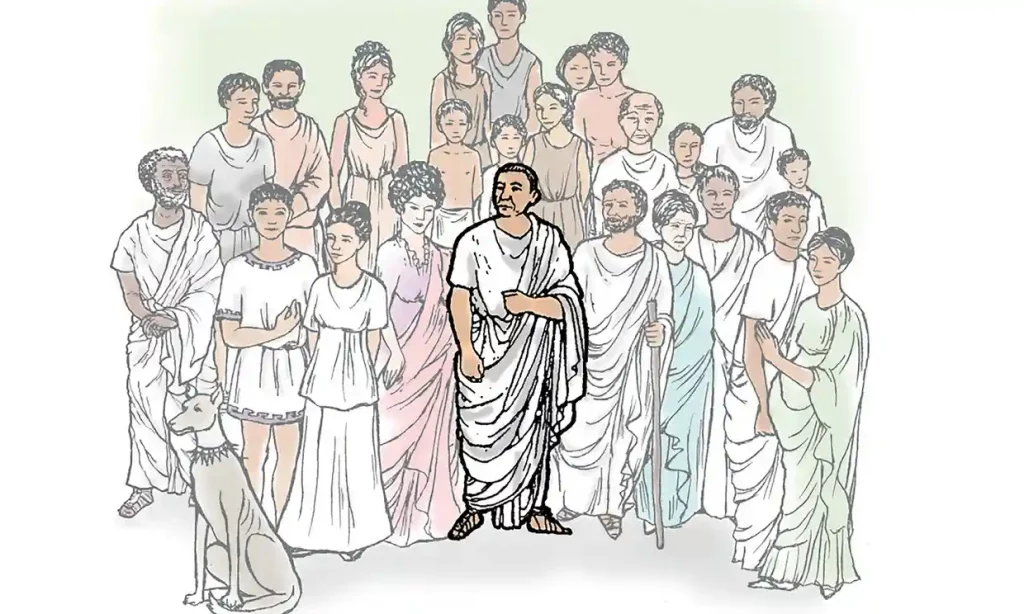Book 1: Caecilus 5.0
The Cambridge Latin Course has endured for so long that it has become a lens through which our subject is viewed by the outside world. Written originally in the 1970s as a radical push-back against traditional methods of Latin teaching, the CLC has become the orthodoxy for recent generations. Whilst complained about and much-discussed by tradtionalists and modernists alike, Book 1 in particular is used in the overwhelming majority of schools that teach Latin. I personally used it throughout my 21-year career, despite having much to say about about its approach and scope; the first book is truly inspired and therefore inspiring, and even those of us who take issue with its theoretical approach to the language find it hard to resist its allure.
The course is currently in the midst of a radical overhaul, overseen by Caroline Bristow and her team of writers at CSCP, whom she describes as passionate curators of the characters and their stories. I recently interviewed Caroline for my podcast, and found her insights into how the course has been restructured and reinvented for the modern world truly fascinating. I immediately ordered myself a copy of what’s already available, which is the first two volumes, and have decided to review the changes to Book 1 in this blog post; next week I shall examine Book 2 as there is far too much to say about both volumes to cover it all in one post. There has been a surprising lack of response from the Classics world about the 5th edition, although its attempts to rethink itself have been seized upon with tedious predictability by certain quarters of the mainstream media, who found themselves in a panic that Caecilius and his friends were going woke.
So what exactly has changed for Caecilius?
To the untrained eye, the changes to Book 1 might seem somewhat superficial. As a perhaps reluctant CLC expert, I can assure you that they are not. I have worked with this course for 21 years and I probably know Book 1 better than most people – not least because I spent the last few years of my career re-writing it in order to resolve some of the concerns I had with its approach. Many of the changes I chose to make were as a result of the fact that I am not convinced by the philosophy behind the CLC and other courses which are usually named “reading courses” – if you’d like to know more about this, then my discussion with Caroline is definitely worth you listening to, as is my final interview of the same season with David Carter, who is an advocate for comprehensible input. My ongoing concerns aside, my focus for this blog post is on the specific changes made between the new 5th edition and its predecessor. The pedagogical philosophy behind the course remains unchanged.
The first thing to say is that the cartoons are now colourised. This may feel less radical and exciting since we have had access to the colourised versions online for some time, but let us not forget that this is the first time that these have appeared in print. The 4th edition was streets ahead of its predecessors in terms of presentation and the use of colour photographs, but Caecilius 5.0 is colourised throughout and the cartoons far more appealing as a result of this simple fact. Aside from this, the cartoons attached to the model sentences remain largely familiar, with the addition of Lucia, a sister for Quintus. She seems like as good a place to start as any, so let’s begin with Lucia and the portayal of women.
Why Lucia – and what about women in general?
There are numerous and overwhelming benefits to the inclusion of a daughter for Caecilius and Metella. To start with the obvious, the book is immediately more balanced, with the addition of a female character being shown reading within the first couple of pages. Her prior non-existence had little to do with the realities of the Roman world and far more to do with the fact that the CLC was written in the 1970s. It may have escaped some people’s notice, but the female characters in the series to date reflect the way in which women were portrayed in 1970s situation comedy: you have nagging wives and and you have pretty girls without much to say for themselves other than what men purport to find pleasing. It is surely not to enter some Daily Express reader’s fantasy of radical wokeness to suggest that we can do better than this now.
Lucia is given an important role in the book and – much as I do not wish for her to be nothing but a foil for the male characters – she does indeed provide opportunities for the writers to flesh out the character of Quintus, who has always been somewhat flat in the first book. I’ll come back to why that’s important later.
In general, the writers have done a magnificent job of illustrating the realities of life as it was for Roman women. Metella has been fleshed out as a character and appears by Caecilius’s side, as per the reality for the wife of a wealthy, successful man. Previously, it had felt like they didn’t have any kind of partnership at all and led entirely separate lives, when the reality would have seen Metella involved in Caecilius’s business relationships and friendships. Some of the changes made are subtle but crucially important for this; for example, the opening line of Fabula Mirabilis now reads “multi amici cum Caecilio et cum Metella cenabant” instead of “multi amici cum Caecilio cenabant”. So Metella is there as a host also. Likewise in the story Felix et Fur it is the daughter, Lucia, who asks why Felix was freed (at last making sense of the use of the 3rd person in the last line, which has always grated on me!) Small tweaks matter, because they flesh out the image of the ancient world we are portraying to children.
At the end of Stage 7, after the radically adapted story that portrays Melissa (more on her below), the authors introduce a new story called Lucia callida, which echoes the language used in the story Decens and shows Lucia and a female friend outwitting a rather unpleasant gladiator. By the by, the feminine version of the Latin word for friend (amica) was not previously used in the book, which only serves to illustrate the extent to which women were overlooked in previous editions.
Workers and slaves
The 5th edition authors swap the painter Celer for a female character called Clara, basing their decision to do so on original sources and opening up the opportunity for teachers to explore with their classes what kind of work women might have been seen performing. They also radically adjust the presentation of the slave girl Melissa, giving her a back story and making her welcomed by the other slaves; previously, the story of Melissa showed her as being easy on the eye, simpering while being purchased by (a potentially somewhat lascivious) Caecilius and appreciated by all the men in the household but not by Metella. Distinctly less than ideal. This has been removed, as has the storyline of Melissa getting everything wrong, being criticised by the other (supremely happy) household slaves and eventually settling in to the proper ways of the house. The story which used to be called Metella et Melissa in Stage 7 has been radically transformed, showing empathy between the household slaves and explaining how Melissa ended up being sold into slavery. Metella is no longer the one who makes Melissa feel at home, it is her fellow slaves.
Empathy is also evoked between the slaves in a very interesting change to Stage 4. The authors have completely adapted the story Grumio et Leo, which previously portrayed Grumio as being so drunk that he mistook a fresh mural for reality and became convinced that there was a lion in the house. Ho ho ho for all concerned, isn’t alcohol abuse hilarious? Possibly less than ideal, one has to admit. The story has now been adjusted and has Melissa comparing the image of Hercules in the painting to Grumio and Clemens being unconvinced. Grumio still retains his naughty side, and rest assured that his ongoing flirtation with Poppaea remains in place, as does Clemens’s smug usurpation at the end of the playlet in Stage 11.
Overall, the shift away from portraying the household as packed with a bunch of enslaved workers who were thoroughly happy with their lot is subtle but distinct.
Foreshadowing Book 2: Quintus and Barbillus
One of the many reasons, in my opinion, that children’s interest in the stories wanes after CLC Book 1, is that students never get over the loss of Caecilius. Quintus is not developed enough as a character in Book 1 for him to become the hero in the later books, and this was one of the ways in which I felt things needed changing (the others all relate to grammar and vocabulary).
The authors of the 5th edition have gone some way towards adjusting this, with extra stories that flesh out the character of Quintus and give him a personality. Quintus audax has been introduced in Stage 8, which shows Quintus hunting with his father and Felix, a hair-raising encounter with a boar affording him the opportunity to pay back his debt to the old freedman. This leads us nicely into him being the focus in much of Stage 9, with his birthday and his visit to the baths, and in Stage 10, with his Greek friend Alexander. Pleasingly, Lucia shows an interest in Alexander in a short interaction with Melissa, and it’s nice to see the main characters forming attractions, which was previously only the preserve of the slaves (read into that what you will).
An inspired change for the better is the pointless characters of Marcus and Quartus have been ditched from Stage 11 and instead the debate regarding which candidate’s name to paint on the wall of their house happens between Quintus and Lucia, giving both characters life and illustrating what we know from the very kind of graffiti being portrayed – that Roman women supported political campaigning and put both their voice and their wealth behind their preferred candidates. Another pleasing addition to this stage is a discussion between Metella and Lucia, in which Metella reveals that Caecilius is looking to his wealthy contact Holconius (boo!) to help him arrange a marriage for Lucia. There is lots of scope for discussion in the story, which shows Lucia’s feelings (she only has eyes for Alexander) and touches on various other themes relating to marriage and how women were treated in the Roman world. The notion of arranged marriage was distinctly missing before, along with pretty much every lived reality for 50% of the population of the ancient world.
One of the cleverest adjustments made by the authors is easy to miss and I confess I might have done so had Caroline Bristow not flagged it up to me in her interview. In a stroke of genius, the authors have tweaked the cartoons and the storyline ever so slightly in Stage 2, taking the previously nameless merchant friend from the cartoons and calling him Barbillus. He then pops up again in Stage 12, replacing the hitherto pointless Iulius, who is introduced in previous editions only to be left to an unknown fate and never mentioned again. As a result of all this, Barbillus – a pivotal character for Book 2 – is flagged as a solid friend and business contact for Caecilius in Book 1, enabling the authors (one hopes) to create more of a bond between him and the surviving members of the family in Book 2 and thus more pathos for his death.
The presentation of the background
As a state school teacher with excessively limited classroom time, I am far less of an expert with how the background material is presented. However, the differences are still striking even to my eye. The “talking heads” are a great idea, as the background sections become an opportunity for the characters to tell us about their lives rather than the background seeming unrelated to them. From what I can see, the authors have also made significant improvements to how the background sections are written, meaning that teachers in a similar situation to mine might at least feel able to set a reading homework for students, facilitated perhaps by the “thinking points” or questions now included to promote discussion; previously, some of the language used was so archaic and/or so advanced that this was never really an option with younger children in a comprehensive setting.
Conclusion: euge!
The 5th edition is a marvellous rewrite and a credit to the authors. I only hope they succeed in persuading schools to make the leap in these financially testing times; to date, I will confess, not one of my tutees is in a school which has made the switch, although it may be early days. But truth be told, if you’re a fan of the course, the new edition holds nothing to fear and everything to like. For pedagogical doubters like myself, I’m afraid that the language elements remain the same, with the one exception that they have (I believe under pressure from teachers) introduced a mention of the ablative case after prepositions in Stage 11. Personally, if I were still a classroom teacher, I would still be teaching the grammar explicitly in the old-fashioned way and I would also still be re-writing the stories to remove nominative pronouns and tweak the vocabulary (small issues like the constant use of contendo – not on the GCSE vocabulary list – instead of festino). I would also still be adjusting the way that the vocabulary is presented (I take issue with verbs being listed in the 3rd person).
I did all this with Book 1 as I believed the story arc was magnificent and maintained an undeniably engaging appeal. Book 2, as of around four years ago, I had ditched altogether for numerous reasons, in particular the excessive use of irrelevant vocabulary which overwhelmed students and caused them to lose all heart. I have not studied Book 2 in detail yet, and look forward to considering whether it could have tempted me back into the fold.

Image from the opening chapter of CLC Book 1


























